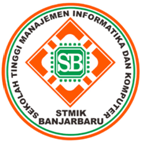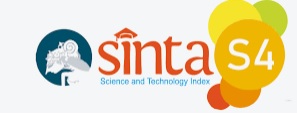Analisis Employee Satisfaction Menggunakan Teknik Clustering Dan Classification Machine Learning
Abstract
Abstrak. Kepuasan kerja pekerja sangat berhubungan dengan pekerjaan maupun kondisi dirinya ditempat kerja. Tingkat kepuasan kerja pekerja dapat di analisis dan menjadi bahan evaluasi perusahaan dalam menjalankan bisnis untuk mencapai target yang diinginkan. Kombinasi teknik clustering dan classification merupakan algoritma machine learning yang dapat membantu bagian Sumber Daya Manusia dalam menganalisis dan prediksi tingkat kepuasan kerja pekerja di perusahaan. Teknik clustering yang digunakan dalam penelitian ini adalah KMeans dan teknik classification menggunakan algoritma classificafier dari library Pycaret. Hasil analisis dari penggunaan teknik clustering dan classification dari ke-5 model classifier yang dipilih, 3 model yaitu LightGBM, Catboost dan XGBoost menunjukkan performa yang konsiten dan menghasilkan tingkat accuracy prediksi diatas 98% dengan jumlah cluster ideal 2, ncomponent 27, waktu proses rata-rata setiap model kurang dari 2 menit setiap tahapan proses dan menggunakan K-means clustering.
Kata kunci: Kepuasan pekerja; Klaster; Klasifikasi; Pembelajaran mesin
Abstract. Job satisfaction of workers is closely related to their work and conditions at work. The level of job satisfaction of workers can be analyzed and become an evaluation material for companies in running a business to achieve the desired target. The combination of clustering and classification techniques is a machine learning algorithm that can assist the Human Resources department with analyzing and predicting the level of job satisfaction of workers in the company. The clustering technique used in this research is K-Means in the classification technique using a binary classification algorithm from the Pycaret library. The results analysis of the clustering and classification techniques from the five selected classifier models, three models namely LightGBM, Catboost, and XGBoost shown consistent performance and the prediction accuracy levels above 98% with the ideal number of clusters 2, n-components 27, the average of processing time each model is less than 2 minutes each stage process and using K-means clustering.
Keywords: Employee Satisfaction; Clustering; Classification; Machine Learning
References
S.J. Conlon, L.L. Simmons, & F. Liu, "Predicting Tech Employee Job Satisfaction Using Machine Learning Techniques". Int J Manag Inf Technol, vol. 16, pp. 72–88, 2021.
H. Gao, M. He, & G. Hou, "A Comparison of Machine Learning Approaches For Employee Satisfaction Prediction", Int J Mod Eng Res, vol. 10, pp. 46–53, 2020.
C.I. Ristianty, Nurwati, Nasrul, et al. "The influence of leadership on human resource empowerment and job satisfaction in improving employee performance". Eur J Mol Clin Med, vol. 7, no. 3844–3852, 2020
Y. Jung, Y. Suh, "Mining The Voice of Employees: A Text mining Approach to Identifying And Analyzing Job Satisfaction Factors From Online Employee Reviews", Decis Support Syst, vol. 123, no. 113074, 2019
S. Andari, "Hubungan Antara Gaya Kepemimpinan Dengan Kinerja Karyawan", Pros Psikol, vol. 5, no.2, pp. 6, 2017.
R.N. Londok, W.A. Areros, & S. Asaloei, "Pengaruh Kepuasan Kerja Terhadap Kinerja Karyawan CV. Diagram Global Mandiri Manado", J Adm Bisnis, no.9, pp. 6, 2019
S.T. Dziuba, M. Ingaldi, & M. Zhuravskaya "Employees’ Job Satisfaction and their Work Performance as Elements Influencing Work Safety", Syst Saf Hum - Tech Facil - Environ, vol. 2, pp.18–25, 2020
C. KUZEY, "Impact of Health Care Employees ’ Job Satisfaction on Organizational Performance Support Vector Machine Approach", J Econ Financ Anal, vol. 2, pp. 45–68, 2018
H. Bodepudi, "Credit Card Fraud Detection Using Unsupervised Machine Learning Algorithms", Int J Comput Trends Technol, vol. 69, pp. 1–13, 2021
M. Usama, J. Qadir, A. Raza, et al. "Unsupervised Machine Learning For Networking: Techniques, Applications And Research Challenges", IEEE, vol. 2, pp. 37, 2019
X. Liu, N. Zhang, "Research on Customer Satisfaction of Budget Hotels Based on Revised IPA and Online Reviews", Science Journal of Business and Management, http://article.bizmgmt.org/pdf/10.11648.j.sjbm.20200802.11.pdf (2020).
R. Hidayati, A. Zubair, P.A. Hidayat, et al. "Silhouette Coefficient Analysis in 6 Measuring Distances of K-Means Clustering", TechnoCom, vol. 20, pp. 186–197, 2021
J.J. Shon, "Employee Satisfaction and Corporate Performance : Mining Employee Reviews on Glassdoor.com". Thirty Seventh Int Conf Inf Syst, pp. 1–16, 2016.
O. Somantri, D. Apriliani, "Support Vector Machine Based on Feature Selection For Sentiment Analysis Customer Satisfaction on Culinary Restaurant at Tegal City". J Teknol Inf dan Ilmu Komput, vol. 5, pp. 537, 2018
Y. Chen, X. Qin, J. Wang, et al. "Fedhealth: A federated transfer learning framework for wearable healthcare". IEEE Intell Syst, https://ieeexplore.ieee.org/abstract/ document/9076082, 2020.
A. Sarker, S.M. Shamim, M. Shahiduz, et al. "Employee’s Performance Analysis and Prediction using K-Means Clustering & Decision Tree Algorithm", Int Res J Softw Data Eng Glob J Comput Sci Technol, vol. 18, pp 7, 2018
A.Al. Malki, M.M. Rizk, "El-Shorbagy MA, et al. Hybrid Genetic Algorithm with K-Means for Clustering Problems", Open J Optim, vol. 05, pp. 71–83, 2016
D.Q. Zeebaree, H. Haron, A.M. Abdulazeez, et al. "Combination of K-Means Clustering With Genetic Algorithm: A Review", Int J Appl Eng Res, vol. 12, pp. 14238–14245, 2017
S.G. Mathias, D. GroBmann, G.J. Sequeira, "A Comparison of Clustering Measures on Raw Signals of Welding Production Data", International Conference on Deep Learning and Machine Learning in Emerging Applications (Deep-ML). Epub ahead of print 2019. DOI: 10.1109/deep-ml.2019.00019, 2019.
A. Adolfsson, M. Ackerman, N.C. Brownstein, "To Cluster , or Not to Cluster : An Analysis of Clusterability Methods", arXiv, vol. 1, pp. 30, 2018
M. Masoud, Y. Jaradat, E. Rababa, et al. "Turnover Prediction using Machine Learning: Empirical Study", Int J Adv Soft Comput its Appl, vol. 13, pp. 193–207, 2021
V. Mulpuru, N. Mishra, "In Silico Prediction of Fraction Unbound in Human Plasma from Chemical Fingerprint Using Automated Machine Learning", ACS Omega, vol. 6, pp. 6791–6797, 2021
E. Larsen, D. Noever, K. Macvittie, et al. "Overhead-MNIST : Machine Learning Baselines For Image Classification", arXiv, vol. 2, pp. 6, 2021
J. Judrups, R. Cinks, I. Birzniece, et al. "Machine learning based solution for predicting voluntary employee turnover in organization", In: Engineering for Rural Development, pp. 1359–1366, 2021
F.L. Gewers, G.R. Ferreira, H.F. Arruda De, et al. "Principal Component Analysis: A Natural Approach to Data Exploration", arXiv, vol. 2, pp. 1–33, 2018
G. Wijngaard. Thesis : Clustering soccer players: investigating unsupervised learning on player positions, 2019.
E. Bisong, "Google Cloud Machine Learning Engine (Cloud MLE)". Building Machine Learning and Deep Learning Models on Google Cloud Platform, pp. 545–579, 2019.
How To Cite This :
Refbacks
- There are currently no refbacks.










